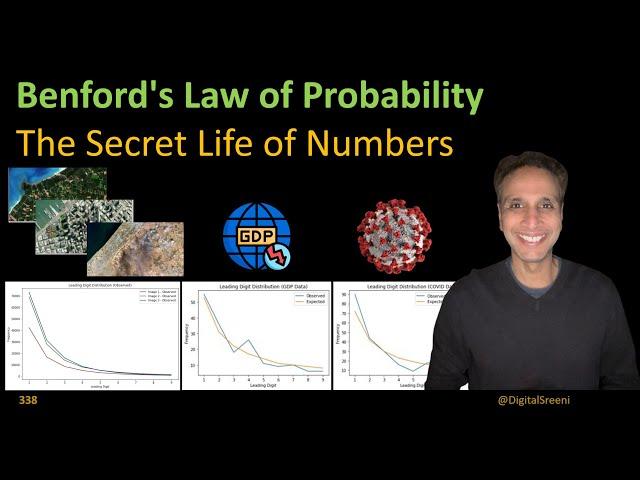
338 - Understanding the Benford's Law of Probability
Benford's Law, also known as the first-digit law, is a statistical phenomenon
observed in many sets of numerical data. It states that in certain naturally
occurring datasets, the leading digits (1, 2, 3, etc.) occur with a higher frequency than larger digits (4, 5, 6, etc.).
According to Benford's Law, the distribution of leading digits follows a logarithmic pattern, where smaller digits are more likely to be the first digit in a number. This surprising and counterintuitive property is frequently encountered in diverse datasets such as financial transactions, population numbers, and scientific data, making Benford's Law a useful tool for
detecting anomalies and irregularities in numerical datasets.
In this tutorial, we analyze the distribution of leading digits in tax deduction, population, GDP, COVID numbers and also pixel distribution in images, with the objective of verifying whether the data adheres to Benford's Law.
The observed frequencies of the leading digits are computed and compared against the expected frequencies predicted by Benford's Law.
Relevant python code is available here: https://github.com/bnsreenu/python_for_microscopists/tree/master/323-Benfords%20Law
Additional Notes:
For the image data:
The code reads images in grayscale using opencv library, computes the DCT coefficients, and plots the observed Benford's Law distribution for each image.
In case you wonder why go through the pain of converting pixel values to DCT...
In the context of Benford's Law, the distribution of leading digits is expected to follow a logarithmic pattern, where smaller digits (1, 2, 3) occur more frequently than larger digits (4, 5, 6, 7, 8, 9). When pixel values are confined to a small range, it can disrupt this natural logarithmic distribution. For example, in 8 bit images, our pixels have values between 0 to 255. So any bright pixel will always have a leading digit of 2 and never have values 3 or greater.
observed in many sets of numerical data. It states that in certain naturally
occurring datasets, the leading digits (1, 2, 3, etc.) occur with a higher frequency than larger digits (4, 5, 6, etc.).
According to Benford's Law, the distribution of leading digits follows a logarithmic pattern, where smaller digits are more likely to be the first digit in a number. This surprising and counterintuitive property is frequently encountered in diverse datasets such as financial transactions, population numbers, and scientific data, making Benford's Law a useful tool for
detecting anomalies and irregularities in numerical datasets.
In this tutorial, we analyze the distribution of leading digits in tax deduction, population, GDP, COVID numbers and also pixel distribution in images, with the objective of verifying whether the data adheres to Benford's Law.
The observed frequencies of the leading digits are computed and compared against the expected frequencies predicted by Benford's Law.
Relevant python code is available here: https://github.com/bnsreenu/python_for_microscopists/tree/master/323-Benfords%20Law
Additional Notes:
For the image data:
The code reads images in grayscale using opencv library, computes the DCT coefficients, and plots the observed Benford's Law distribution for each image.
In case you wonder why go through the pain of converting pixel values to DCT...
In the context of Benford's Law, the distribution of leading digits is expected to follow a logarithmic pattern, where smaller digits (1, 2, 3) occur more frequently than larger digits (4, 5, 6, 7, 8, 9). When pixel values are confined to a small range, it can disrupt this natural logarithmic distribution. For example, in 8 bit images, our pixels have values between 0 to 255. So any bright pixel will always have a leading digit of 2 and never have values 3 or greater.
Тэги:
#microscopy #python #image_processingКомментарии:
338 - Understanding the Benford's Law of Probability
DigitalSreeni
한국음식 많이 싸들고, 스웨덴에 왔어요. (새 아파트 인테리어 시작)
펩선 PEPSUN
295 - ONNX – open format for machine learning models
DigitalSreeni
Chicago Pizza Vs New York Pizza (Who’s better?)
Jordan Howlett
أخيرا الشتوي شاف النور .. يوم أجازة زوجي استغليت الوقت اللي قضيته في البيت وعملت الحلو كله..
يوميات إسراء Esraa Esmail
Время пришло! Делаем ремонт в прихожей. Вот так стройка. Жизнь простых людей в деревне.
Дом у дороги. Деревенская жизнь.
The Power Of Seeing Jesus In The Word | Joseph Prince Ministries
Joseph Prince Ministries - USA
DZIEŃ Z ŻYCIA #24
Zaksiążkowane











